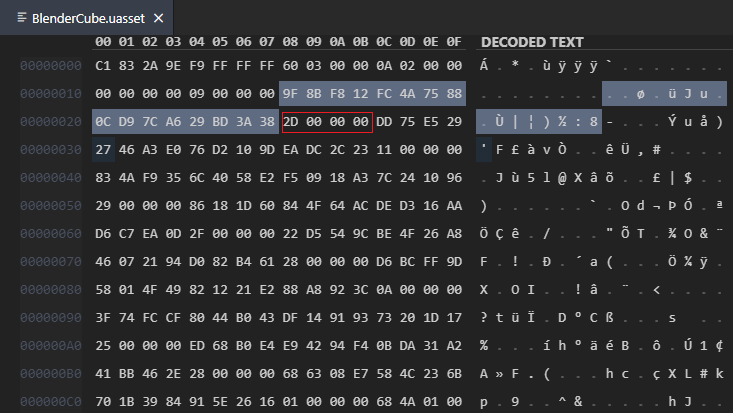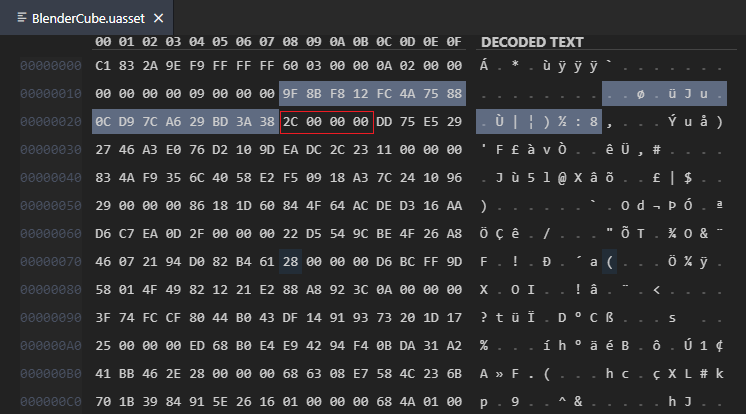How to downgrade Unreal Engine assets
03 Jul 2021 unrealYou try updating your project to a newer Unreal Engine version, play around for a bit and realize you need to revert to a previous version. You already changed and resaved some of your assets though, what can you do?
I couldn’t find a solution to this after a quick search, but I’ve used a hack for this before that could be useful. Note that this is sort of a “last resort”, and should almost always be a bad idea.
DISCLAIMER: Please make sure you backup your assets somewhere else before trying this, as this hack could permanently destroy them!
The problem
For this sample I’ll move a static mesh asset that was saved in 4.27 Preview 2 down to 4.26.2, but this should work for any pair of UE4/5 versions. You’ll get into more trouble the further apart the engine versions are, though.
Anyway, if I just try opening the asset saved in 4.27P2 with my 4.26.2 engine and project, I get an error that looks like this:
LogAssetRegistry: Error: Package E:/Unreal projects/Test_426/Content/BlenderCube.uasset has newer custom version of Dev-Rendering
The cause
What is a Dev-Rendering? Check DevObjectVersion.cpp. The relevant snippet looks like this:
// Unique Rendering Object version id
const FGuid FRenderingObjectVersion::GUID(0x12F88B9F, 0x88754AFC, 0xA67CD90C, 0x383ABD29);
// Register Rendering custom version with Core
FDevVersionRegistration GRegisterRenderingObjectVersion(FRenderingObjectVersion::GUID, FRenderingObjectVersion::LatestVersion, TEXT("Dev-Rendering"));
Here is the start and end of that FRenderingObjectVersion enum:
// Custom serialization version for changes made in Dev-Rendering stream
struct CORE_API FRenderingObjectVersion
{
enum Type
{
// Before any version changes were made
BeforeCustomVersionWasAdded = 0,
// Added support for 3 band SH in the ILC
IndirectLightingCache3BandSupport,
// Allows specifying resolution for reflection capture probes
CustomReflectionCaptureResolutionSupport,
RemovedTextureStreamingLevelData,
... // Lots more
// Remap Volume Extinction material input to RGB
VolumeExtinctionBecomesRGB,
// -----<new versions can be added above this line>-------------------------------------------------
VersionPlusOne,
LatestVersion = VersionPlusOne - 1
};
// The GUID for this custom version number
const static FGuid GUID;
private:
FRenderingObjectVersion() {}
};
This enum works like a version tracker for the Dev-Rendering “custom version”. The idea is that they can have entries in that enum that correspond to changes that affect serialized assets.
Saved uassets (static meshes, materials, even levels) can get serialized with that GUID we saw before (0x12F88B9F, 0x88754AFC, 0xA67CD90C, 0x383ABD29, which identifies Dev-Rendering), and the current value of FRenderingObjectVersion::LastVersion, which means the asset requires this particular version (or later) of the Dev-Rendering custom version.
Whenever the asset is deserialized, what it thinks the value for FRenderingObjectVersion::LastVersion is is retrieved from the file and compared with the engine’s own value for FRenderingObjectVersion::LastVersion.
If the asset has a lower value for LastVersion, it means it was saved with an older engine version (that had less entries in that enum). This is usually not an issue though, because developers can write code on UObject::Serialize(FArchive& Ar) overloads that can automatically upgrade the older asset to the current engine version upon loading, since they know what the serialized representation looked like before and what it should look like now.
If the asset has a higher number for LastVersion, it means that the enum had more entries when the asset was saved, i.e. the asset was saved with a newer engine version. The developers can’t do much about that unfortunately: The way the asset is represented on disk can have arbitrarily changed in some way our engine doesn’t understand yet, so the loading is aborted.
You can see where this is going: It’s pretty risky to try this if you’re trying to downgrade a material and the version for Dev-Rendering changed, but it shouldn’t be impossible to manually downgrade something like a static mesh if only the version of FortniteRelease changed, or something like that. Likely our mesh doesn’t have any Fortnite data stored in it, so it’s serialized representation on disk probably hasn’t changed much even though FortniteRelease has. Luckily these GUIDs and values are stored uncompressed/unhashed on the asset files, so we can do something about it.
The workaround
These version numbers can be tweaked on the assets directly. Here is what the start of that BlenderCube.uasset asset looks like on a hex editor. It doesn’t matter what asset (or asset type) it is, this “file header” should always have more or less the same structure.
This header corresponds to a serialized FPackageFileSummary by the way, and you can see the serialization process here.
Anyway, the highlighted bit is our Dev-Rendering GUID, except that it was serialized as little endian. TL;DR: It will be written to disk inverting the order of bytes (pair of characters) in each of the values in the GUID, so the first group 0x12F88B9F, which has the bytes 12 F8 8B 9F, becomes 9F 8B F8 12, which is the start of the highlighted text on that image.
The value in red right after the GUID is the current value for the Dev-Rendering enum: 0000002D, which is hexadecimal for 45. Our asset was saved with FRenderingObjectVersion::LastVersion = 45.
If you just switch between the 4.27 and 4.26 branches on the file of the enum’s declaration you can see that it has gained a new entry in 4.27: VolumeExtinctionBecomesRGB. This means that in 4.26, LastVersion was probably just 44, which is 2C. We can just write 2C there and save:
This should do it. Realistically though, not just Dev-Rendering will change between engine versions, and you’d have to repeat this about 5-10 times for different enums.
The faster workaround
I made a small Python 3 script that should help with the tediousness of this, though. It will make sure that e.g. the value for Dev-Rendering is at most the one that you set it. It has all the custom versions listed on DevObjectVersion.cpp plus the Release custom version, but you may need to manually add others that fit your cases, as individual plugins may also define their own custom version.
Hopefully the script is self-explanatory: The idea is to watch the UE Output Log for errors like we originally saw:
LogAssetRegistry: Error: Package E:/Unreal projects/Test_426/Content/BlenderCube.uasset has newer custom version of Dev-Rendering
Then add entries for those custom versions (here, Dev-Rendering again) with the -1 value within the script’s updated_values dict to probe what the value currently is. The script will output something like Read 'Dev-Rendering' with value '45'. Knowing that, you can change the -1 value to 44 and run the script again to downgrade it to 44 instead. Once you run the script the file will be saved and UE will try loading it again, potentially outputting another error like custom version mismatch for FortniteMain. Repeat until it stops complaining.
The complete workaround
I’ve used this a couple times before and it works fine, and it should at least always get your asset to show up on the Content Browser. This is all you need if you’re working on UE source and want to downgrade between different changelists, and your build version is still compatible with the asset.
If you are moving an asset between different major/minor versions though (like we are doing here by moving it from 4.27P2 to 4.26.2), then we need one extra step.
After you run the script (or did the version changes manually), the asset will show up on the Content Browser. If you double-click the asset though, you’ll get a warning like this on the Output Log:
LogLinker: Warning: Asset 'E:/Unreal projects/Test_426/Content/BlenderCube.uasset' has been saved with a newer engine and can't be loaded. CurrentEngineVersion: 4.26.2-15973114+++UE4+Release-4.26 (Licensee=0). AssetEngineVersion: 4.27.0-16724560+++UE4+Release-4.27 (Licensee=0)
The major/minor versions, engine and compatible changelists and Perforce stream names are also saved on the asset, and the engine is trying it’s best to prevent us from loading it (as it should, as this is a pretty bad idea in general!).
Because of this we need to provide the major/minor/changelist versions to the script as well, so that it can replace that for us. In our case, from that error message we can tell that our asset has major=4, minor=27, changelist=16724560, and our engine has major=4, minor=26 and changelist=15973114. On the script, set update_engine_version to True after you set these values on the variables defined right after it, and then run it.
This is it, for real this time! If you can double-click now make sure you save your asset as soon as you can, so that it can be serialized correctly to disk by the engine, hopefully ironing out any small details we could have missed.
If this doesn’t work for you and your asset just crashes when opening, you may be in deeper trouble unfortunately. The versions could be far enough apart that the serialized representation of your asset changed on disk in some non-trivial way. It’s probably not worth it to try and make sense of it, and you should just try recreating/reimporting your asset instead (or find an even crazier hack :) ).

